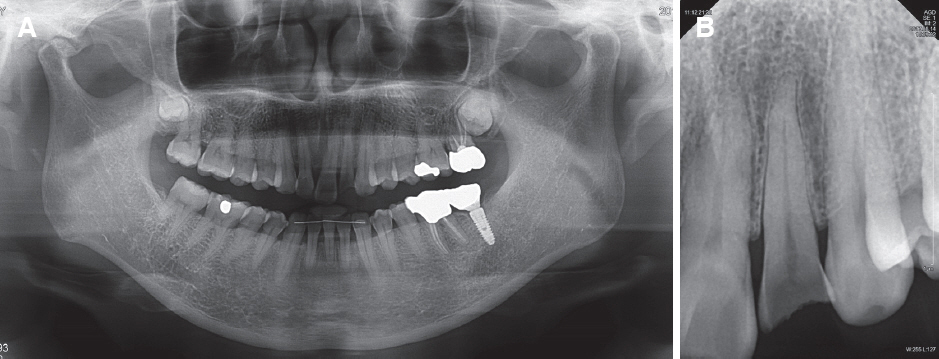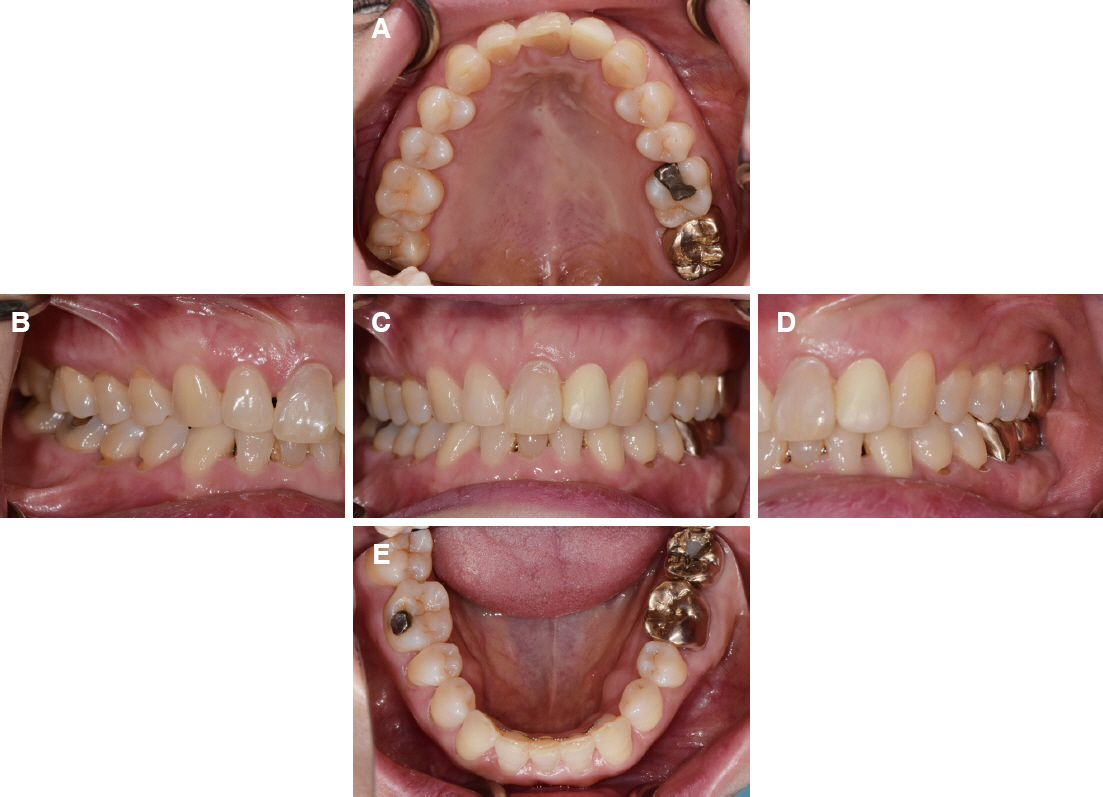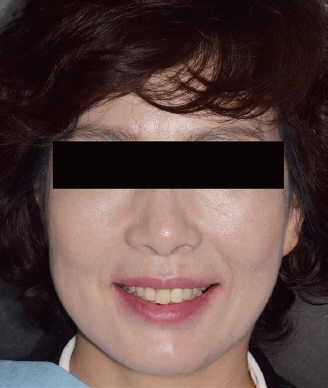J Dent Rehabil Appl Sci.
2019 Sep;35(3):170-179. 10.14368/jdras.2019.35.3.170.
Anterior esthetic restoration using DSD (digital smile design) for a patient with congenital missing tooth of maxillary central incisor
- Affiliations
-
- 1Department of Prosthodontics, College of Dentistry, Dankook University, Cheonan, Republic of Korea. jseok2@hanmail.net
- KMID: 2463626
- DOI: http://doi.org/10.14368/jdras.2019.35.3.170
Abstract
- The prosthodontic treatments in maxillary anterior teeth focus on achieving esthetic appearances. It is possible to improve the esthetic appearance by adjusting the shape, arrangement, and color of the maxillary anterior teeth. For anterior teeth restoration, it is necessary to evaluate the relationship of teeth, lip and gingival architecture with the facial profile of patient. Also, clinician needs to fully understand what the patient wants to. DSD (digital smile design) concept can be applied as a tool to improve communication with the clinician, technician and patient. In addition, DSD can help to meet the needs of the patient. In this case, it was impossible to achieve symmetry due to congenital missing of maxillary central incisor. The definitive treatment goal was to get the harmony of maxillary anterior teeth, lip and the patient's face. This case report describes that the patient and clinician got the satisfying esthetic outcome by using DSD.
Figure
Reference
-
References
1. Mclaren EA, Culp L. Smile analysis the photoshop smile design technique:Part I. J Cosmet Dent. 2013; 29:94–108. PMID: 24571506.2. Paolucci B, Calamita M, Coachman C, Gurel G, Shayder A, Hallawell P. Visagism:The art of dental composition. Quintessence Dent Technol. 2012; 35:187–200.3. Coachman C, Calamita M. Digital smile design:a tool for treatment planning and communication in esthetic dentistry. Quintessence Dent Technol. 2012; 35:103–11.4. Sulikowski A, Yoshida A. “Three-dimensional management of dental proportions:a new esthetic principle-”The frame of reference. Quintessence Dent Technol. 2002; 25:8–20.5. Marcushamer E, Tsukiyama T, Griffin TJ, Arguello E, Gallucci GO, Magne P. Anatomical crown width/length ratios of worn and unworn maxillary teeth in Asian subjects. Int J Periodontics Restorative Dent. 2011; 31:495–503. PMID: 21845244.6. Sabri R. The eight components of a balanced smile. J Clin Orthod. 2005; 39:155–67. PMID: 15888949.7. Chu SJ, TAN JH, Stappert CF, Tarnow DP. Gingival zenith positions and levels of the maxillary anterior dentition. J Esthet Restor Dent. 2009; 21:113–20. DOI: 10.1111/j.1708-8240.2009.00242.x. PMID: 19368601.8. Bagby M, Marshall SJ, Marshall GW Jr. Metal ceramic compatibility:a review of the literature. J Prosthet Dent. 1990; 63:21–5. DOI: 10.1016/0022-3913(90)90259-F. PMID: 2404102.9. Magne P, Magne M, Belser U. The esthetic width in fixed prosthodontics. J Prosthodont. 1999; 8:106–18. DOI: 10.1111/j.1532-849X.1999.tb00019.x. PMID: 10740509.10. Isgro G, Pallav P, van der Zel JM, Feilzer AJ. The influence of the veneering porcelain and different surface treatments on the biaxial flexural strength of a heat-pressed ceramic. J Prosthet Dent. 2003; 90:465–73. DOI: 10.1016/j.prosdent.2003.08.003. PMID: 14586311.11. Coachman C, Van Dooren E, Gurel G, Landsberg CJ, Calamita MA, Bichacho N. Smile design:From digital treatment planning to clinical reality. Cohen M, editor. Interdisciplinary treatment planning Vol 2:Comprehensive case studies. Chicago: Quintessence;2012. p. 119–74.12. Shin S, Noh K, Kwon KR, Kim HS. Use of Digital Smile Design in esthetic restoration in anterior teeth:A case report. J Korean Acad Prosthodont. 2017; 55:164–70. DOI: 10.4047/jkap.2017.55.2.164.13. Meereis CT, de Souza GB, Albino LG, Ogliari FA, Piva E, Lima GS. Digital smile design for computer-assisted esthetic rehabilitation:two-year follow-up. Oper Dent. 2016; 41:E13–22. DOI: 10.2341/14-350-S. PMID: 26509231.14. Lin WS, Zandinejad A, Metz MJ, Harris BT, Morton D. Predictable Restorative Work Flow for Computer-Aided Design/Computer-Aided Manufacture-Fabricated Ceramic Veneers Utilizing a Virtual Smile Design Principle. Oper Dent. 2015; 40:357–63. DOI: 10.2341/13-295-S. PMID: 25706616.15. Pimentel W, Teixeira ML, Costa PP, Jorge MZ, Tiossi R. Predictable outcomes with porcelain laminate veneers:a clinical report. J Prosthodont. 2016; 25:335–40. DOI: 10.1111/jopr.12413. PMID: 26633080.16. Zanardi PR, Laia Rocha Zanardi R, Chaib Stegun R, Sesma N, Costa BN, Cruz Lagana D. The use of the digital smile design concept as an auxiliary tool in aesthetic rehabilitation:a case report. Open Dent J. 2016; 10:28–34. DOI: 10.2174/1874210601610010028. PMID: 27006721. PMCID: PMC4780488.17. Zandinejad A, Lin WS, Atarodi M, Abdel-Azim T, Metz MJ, Morton D. Digital workflow for virtually designing and milling ceramic lithium disilicate veneers:a clinical report. Oper Dent. 2015; 40:241–46. DOI: 10.2341/13-291-S. PMID: 25706612.18. Trushkowsky R, Arias DM, David S. Digital Smile Design concept delineates the final potential result of crown lengthening and porcelain veneers to correct a gummy smile. Int J Esthet Dent. 2016; 11:338–54. PMID: 27433549.
- Full Text Links
- Actions
-
Cited
- CITED
-
- Close
- Share
- Similar articles
-
- Use of Digital Smile Design in esthetic restoration in anterior teeth: A case report
- Using 3-dimensional digital smile design in esthetic restoration of anterior teeth: A case report
- Esthetic improvement in the patient with one missing maxillary central incisor restored with porcelain laminate veneers
- Esthetic restoration using Digital Smile Design: a case report
- Usage of digital technique to facilitate communication between dentist, dental lab technician, and patients in diagnosis and restoration for maxillary anterior implant: a case report












